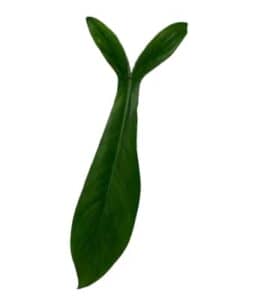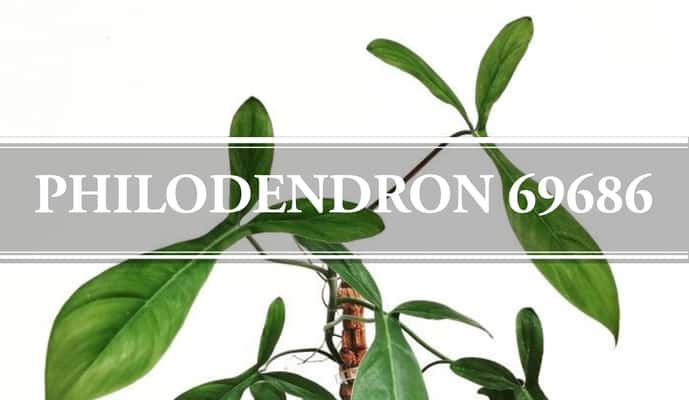Have you ever come across a plant species that is still not named yet? Well, philodendron 69686 is one such species. This species name is based on its classification number. The name controversy of this special plant stems from a deep-rooted confusion since 2005. Botanists have yet to determine the origin of this special plant to award it its distinctive name.
The philodendron 69686 is a hybrid and so it takes many forms. This rare hybrid has rounded tri-lobed leaves, which give it a trendy appearance. It also has a very swift growth cycle, making it a popular choice for lazy plant lovers.
Excited to learn more about this one-of-a-kind species? Read on to find out detailed guidelines about the maintenance of the unique Philo 69686.
Philodendron 69686 Classification
Family: Araceae
Genus: Philodendron
History
Philodendron 69686 is an aroid, thus, in ancient times the known species of the philodendron were grouped under the genus Arum. As more species were discovered, the genus philodendron was created to enable more accurate classification. And it was only after this, that discoveries were placed under the correct genus of philodendron.
Genus Philodendron
Philodendron has been identified as an extensive genus of flowering plants belonging to the family Araceae. It is the second-largest member of the Araceae family with approximately 489 identified species.
This mighty genus is still not completely discovered. A large variety in the genus philodendron remains unexplored. Still, the known species are a sought-after option for ornamental and home plants.
Features of Philodendron 69686 Plant

Structure
This Brazilian hybrid has characteristic hourglass-shaped leaves. You can also identify 69686 philodendrons by the bright yellow variegations present on their leaves.
Size
The greatest height that can be attained by a grown philodendron 69686 when planted indoors is 2 feet. Yet, it can grow up to a surprising 4 feet in its native environment. The leaves of this species can grow as long as 33 cm in length.
Leaves
You cannot miss the bright green smooth-textured leaves of the philodendron 69686. The spectacular tri-lobed leaves have a shiny appearance giving the plant a majestic look.
Flowers
The plant belongs to the Araceae family that seldom blooms when you plant it indoors. But, in its natural habitat, it produces spectacular white-colored flowers.
Toxicity
It is generally not considered very toxic. Yet, you should still practice caution as it is not fit for human consumption either. Consuming any part of the plant can cause mild adverse effects in both animals and humans.
There is no evidence, however, of death occurring as a result of philodendron ingestion.
Dormancy
The growth rate of the plant retards during the winter months. This happens in response to the lowered winter temperature and decreased amounts of sunlight. The change in the growth rate indicates the dormant period of your 69686 philodendron.
Dormancy of the plant is a natural phenomenon and nothing to stress over. However, during the dormant phase, you should refrain from fertilizing or excessive watering of the plant. These precautions must be followed as the dormant plant stops nutrient absorption in the inactive phase.
Philodendron 69686 Care
The philodendron 69686 is a low-maintenance plant and is easy to care for. The right combination of humidity, sunlight, temperature, water, and the correct soil requirements can do wonders for your plant.
To care for your beloved Philo in the right way, have a look at some quick guidelines below.
Quick Guidelines
Water: Once or twice a week
Light: Bright, indirect sunlight exposure
Humidity: Likes ample humidity
Temperature: Between 12 to 32 degrees celsius
Fertilizer: Once every two to three weeks
Place Requirements
Philodendron 69686 can grow well in outdoor as well as indoor environments. When planted outdoors this species can very well climb up any support that is offered to it. This can include a vertical trellis, a totem, or even a tree.
You can plant this species indoors in pots and water containers. The roots of these plants are susceptible to damage when grown in pots. Therefore, you must pay special attention to the root systems of these plants when growing them in pots indoors.
Water Requirements
Water requirements of the philodendron 69686 are not in excess. It is a moderately water-loving plant. A standard plant of this variety needs to be watered only once or twice a week at the most.
However, the philodendron has varying water needs during the summer and winter seasons. You should alter the watering schedule of your plant during the summer and winter months to ensure the best growth. Its water requirements decrease during the colder months. Hence, watering it every ten days is fine during winters.
Important Instructions
About watering, there are a few precautions that you must keep in mind to keep your philodendron 69686 healthy. Overwatering can lead to root rot and the death of the plant.
To avoid the risk of water poisoning, let the top layer of soil dry out between watering bouts. Furthermore, ensure the clearance of the drainage hole of the pot your Philo is planted in. The drainage hole helps to get rid of the excess water present within the soil after a watering spell.
Sunlight Requirements
Exposure to bright, indirect sunlight is the key to keeping your Philo in mint condition. Without adequate sunlight, the photosynthesizing ability of the plant is compromised.
This can result in wilted and yellow leaves, affecting the appearance of your plant. It is necessary to maintain a constant source of light for your plant. Otherwise, the foliage is likely to be damaged.
Temperature Requirements
Saving your plant companion from temperature extremes is the best thing you can do for it. Moderate temperature conditions are ideal for the growth of philodendrons.
The temperature range between 12 to 32 degrees celsius is best suited to its growth. This plant variety is unable to tolerate weather conditions that are too hot or too cold. Therefore, you need to shift them to a suitable environment, like a greenhouse, during the cold winter months.
Soil Requirements
The ideal soil requirements for this plant are airy, loose, and well-drained. Besides this, you should ensure a suitable acidic pH of the growth medium. A pH range from 5.5 to 6 has been shown to get exemplary results.
A simple hack to maintain an acidic growth environment for your philodendron is to spray the top layer of soil with weakened vinegar.
A surprising fact about the philodendron is that it can grow in soilless growth mediums as well. An example of one such substrate is 100 % sphagnum peat moss.
Humidity Requirements
Philodendron 69686 is a humidity-loving plant, owing to its natural tropical rainforest habitat. The humidity of more than 60% is a quintessential need for this plant to thrive.
You can try various methods to increase the level of indoor humidity. Try clustering your indoor plants together to provide a humid environment for all of them together. Another simple way to achieve greater humidity levels is to use humidifiers and pebble trays.
Fertilizer Requirements
The ideal fertilizing frequency of your plant must be once every 2 to three weeks. Chemical fertilizers have the advantage of containing the right proportion of all essential nutrients required by your plant. But using them might harm the roots of this plant.
To avoid this you can opt for organic fertilizers which provide the necessary nutrition without causing significant adverse effects.
Organic fertilizing options can be sourced from your kitchen. Some of these options include; banana peels, eggshells, fallen foliage from trees, and coffee beans.
Pruning Requirements
Trimming the dead leaves off of your philodendron 69686 is an essential care ritual you should perform. This plant can self shed dead leaves. But practicing to prune your Philo can pay off as a well-maintained plant at all times.
While pruning, make sure to start from the bottom of the plant and always use disinfected gardening tools.
Repotting Requirements
You should consider repotting the philodendron on an annual basis during springtime. Repotting the plant helps to aid in better nutrient absorption. Furthermore, repotting the plant provides it with more space to grow as well.
Growth Zones
The spectacular philodendron 68696 is a diverse species that can grow in varying habitats. You can see it growing as part of the tropical forest’s flora. But its growth zones are by no means limited to a certain geographical location.
However, according to the USDA, the ideal growth zone for philodendron 69686 is 9a.
Philodendron 69686 Propagation
The philodendron 69686 is a rare variety and, therefore, must be propagated to ensure the extension of this exceptional species. It is easy to grow this plant from stem cuttings including at least two joints.
The stems can be grown in pots containing a mixture of sand and peat moss. The pots must be placed in greenhouses with average temperatures ranging from 21 to 24 degrees celsius.
The cuttings will need your special attention until the rooting phase. Be careful to keep the propagation pots in partial shade until rooting. After this stage, the pots can be shifted outdoors, given the climate conditions are mild. You can also transfer your rooted cuttings to larger pots if you wish to.
Since Philo 69686 is a trailing plant it can also be rooted in water. A standard philodendron takes approximately 4 to 5 weeks to grow roots, after which it can be cultivated in a bigger pot.
Related Posts:
Why is my Venus Fly Trap drooping?
Summary
The philodendron is a remarkable plant species belonging to the Araceae family. It is a fast-growing plant requiring simple conditions to thrive in. Its vining ability and low maintenance make it a much-loved option for plant connoisseurs globally.
With the right guidelines on how to care for the philodendron 69686, you can enjoy it as an indoor plant mate for yourself.

